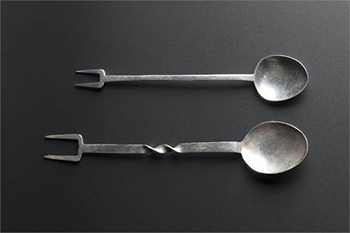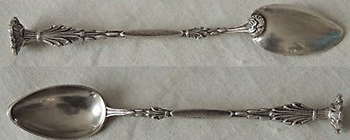There are three main types of spoons used behind the bar but which one is historically considered the ‘bar spoon’?
So let’s start with getting the elephant out of the way. For you pedantic shits out there yes there are strictly speaking four types of bar spoon but you are classy people so we are going to ignore the ‘red top’ bar spoon as it’s cheap and nasty and you’re better than that.
To steal from Friends the three types go like this – the one with the fork, the one with the muddler and the pretty one (or the Rachel).
Whilst nowadays these three spoons are seen almost exclusively behind a bar, or in a draw in someones house next to the pizza wheel and wine stopper not really getting used, two of them started life as a tool for customers.
Sucket Spoon
The sucket spoon, or the one with the fork, appears to be the earliest of the modern day bar spoon designs. The design of a spoon on one end and a fork on the other actually came from Germany although the name originates from the UK.

It was brought over to the UK by the Norman’s and was used, as it had been in Germany, as a handy eating tool for those on the move, just think you could be stirring your drinks with a long spork in an alternate universe. It took it’s name from a dish loved by many, including Queen Elizabeth I, called sucket.
Sucket is a fruit desert that consists of solid elements (candied fruits in essence) and wet elements (a syrupy affair) which would require both a fork and spoon to eat, or a sucket spoon. For no other reason than the fact that old recipes are hilarious here is a recipe for sucket from 16th century writer Gervase Markham:
Take curds, the parings of lemons, of oranges or pomecitrons, or indeed any half ripe green fruit, and boil them till they be tender, in sweet wort; then make a syrup in this sort: take three pound of sugar, and the whites of four eggs, and a gallon of water; then swinge and beat the water and the eggs together, and then put in your sugar, and set it on the fire, and let it have an easy fire, and so let it boil six or seven walms, and then strain it through a cloth, and let it seethe again till it fall from the spoon, and then put it into the rinds of fruits.
It wasn’t until the mid to late 1800’s that the sucket spoon began to be popularised in bars however, even then it was mainly used by the customer rather than the bartender. The sucket spoon was given to customers with drinks which contained fruit so that they could spear the fruit and chomp down. Presumably also useful if you couldn’t find the second set of darts.
Mazagran Spoon
The mazagran spoon, or the one with the muddler, came to prominence in bars at roughly the same time as the sucket spoon however its history doesn’t extend back quite as far.
This time we have the French to thank. The mazagran spoon began life as a tool used by apothecary’s around the 1700’s. Once again the name came some time after this thanks a a battle that was seemingly reported by the Daily Mail of its time.

In 1840 the French were, in a rather unpopular move, occupying Algeria. There was a battle in which 132 French troops defended a fortification in Mazagran against an un-agreed on number of Arab and Berber forces for a few days. They survived and France, in particular Paris, got crazy excited.
The Parisian press claimed they had defended against ‘thousands’ of troops (some claiming tens of thousands) and people ate it up. A replica of the fortress was erected at the Champs Elysées and all sorts of tatt was flogged, a Paris street was named and various medals were given out.
Someone came up with a cold coffee drink named after the battle, supposedly based on the fact that the troops had run out of the brandy they traditionally had with their coffee and had to use water. Basically it was espresso, water and sugar beet lumps which needed to be muddled (it quickly started to have Cognac added to it because, well it’s better), served long and in a glass.
Of course to muddle the sugar beet into the drink customers needed a tool and the apothecary spoon was repurposed and renamed. It didn’t take long for the spoon to move out of the customers hands and into those of drink slingers.
Bar Spoon
Okay so that heading may have given it away. It’s also the most boring story. Sorry.
In catalogues at the end of the 1800’s both sucket and mazagran spoons were advertised and listed, as were bar spoons. These simply had a spoon on one end and a twisted stem. Nothing on the other end.
To say that these were the first with a twisted stem would be a stretch to say the least but it seems to have been a more common design feature in the ‘bar spoon’ than either of the other incarnations .
These days they tend to have a weighted element on the other end, such as a teardrop, to help the spoon work more effectively when stirring down your drink. This is also the point of the twisted stem, as opposed to pouring tonic down it as every Spanish bartender seems to be inexplicably obsessed with.
These days it seems that the sucker in particular but also the mazagran, once the staple of any bar are going out of fashion with a spoon that looks good (how long is yours?) taking preference over one with a useful secondary function.
I would argue, even if you don’t have a dart board, that all these spoons have a place behind a bar. One last point, how many mls does your bar spoon hold? Sure? Have you measured it? Sometimes form and sexy looks can mean more to a manufacturer than accuracy and if you are using multiple different spoons to measure 5mls it might be worth checking you actually are.


